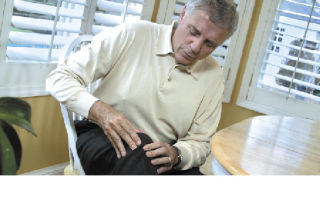Osteoarthritis of the knee develops gradually over time with symptoms like stiffness after getting out of bed or sitting for a long period of time, pain, swelling, tenderness or a crunching sound when walking.
Osteoarthritis, also known as “wear and tear” arthritis, is a degenerative joint disease that affects knees, hips, back and small joints in the fingers. Osteoarthritis of the knee is the most common form of the disease. It is the most common disability found among Americans, affecting more than 10 million people in the United States today. That number is expected to double over the next 20 years.
What is Osteoarthritis?
In the knee, healthy cartilage and joint fluid provide a smooth cover over the top of the tibia (shin bone) and the bottom of the femur (thigh bone). This allows the bones to glide over each other and help absorb the shock of movement.
Osteoarthritis causes the cartilage to deteriorate. Without any lubricant between the bones, they rub together causing pain, swelling and loss of motion. Left untreated, tiny bone spurs may develop and bits of bone or cartilage can break off and float around, resulting in greater pain and damage to the joint.
Causes
While the cause of osteoarthritis is unknown, there are several risk factors for developing the disease. These include:
• Age – approximately 80 percent of people 75 and older show signs of osteoarthritis.
• Genetics.
• Joint abnormalities – caused by abnormal movement and alignment or developmental deformities.
• Muscle weakness around knee.
• Weight – extra weight causes extra stress on knee joint. A recent study shows that obese people are four times as likely to develop osteoarthritis of the knee as they are to develop high blood pressure or Type 2 diabetes.
• Previous knee injury
• Repetitive strain on the knee
Symptoms
Osteoarthritis of the knee develops gradually over time. Primary symptoms include stiffness after getting out of bed or sitting for a long period of time; pain, swelling or tenderness; or a crunching sound when walking.
Diagnosis
Your doctor can diagnose osteoarthritis of the knee by taking a medical history and doing a physical exam. In some cases, blood tests may be ordered to rule out other forms of arthritis. He or she may also order weight bearing X-rays to assess the severity or progression of the disease. X-rays also help rule out other conditions with similar symptoms, such as a torn meniscus or kneecap problems.
Treatment
There is no cure for osteoarthritis but there are ways to help slow the progression of the disease and alleviate pain. Pain can range from mild to severe. Treatments focus on improving joint function, controlling pain, maintaining a healthy weight and achieving an active lifestyle.
The primary goal of treatment is to relieve pain. Physical therapy, combined with medication, work best in the early stages of the disease. In addition to helping improve flexibility and movement, physical therapy can help strengthen the muscles around the joint to improve stability and balance. If you are overweight, you should also talk to your doctor about proper nutrition and exercise.
Injection Therapy
There two different types of injections used to treat symptoms of osteoarthritis; one acts as an anti-inflammatory and the other a joint lubricant.
Cortisone injections are reserved for those with severely inflamed knees and uncontrolled pain. While relief after one injection may last up to four months, evidence suggests subsequent injections are less effective. Because steroids may cause further deterioration in the joint and surrounding structures, repeat injections are usually limited to three or four times during a one-year period of time.
Viscosupplementation therapy involves injecting a gel-like substance (known as Hyalan or Synvisc) into the knee. The gel is made from hyaluronic acid, the fluid naturally produced by the body to help lubricate joints. People with osteoarthritis tend to have a lower concentration of hyaluronic acid in their joints. Injections help restore fluid and cushioning, which can alleviate pain and symptoms for up to 6 months or more. Injections are relatively painless and done in the doctor’s office. A series of three injections is given over a period of 14 to 21 days. A recent report by the American Academy of Orthopaedic Surgeons states that almost 75 percent of patients were able to delay knee replacement surgery after using Synvisc treatments.
One in four people with osteoarthritis of the knee will eventually need surgery. However, treating symptoms early can help delay or even prevent surgery. Talk to your doctor about your personal risk factors and options for managing or preventing this disease.
Dr. Jude Verzosa is an American Board of Internal Medicine certified internist and a hospital medicine physician. He serves as the vice president for the Enumclaw Regional Hospital’s medical staff. He works at Enumclaw Medical Center, part of the Franciscan Medical Group.


